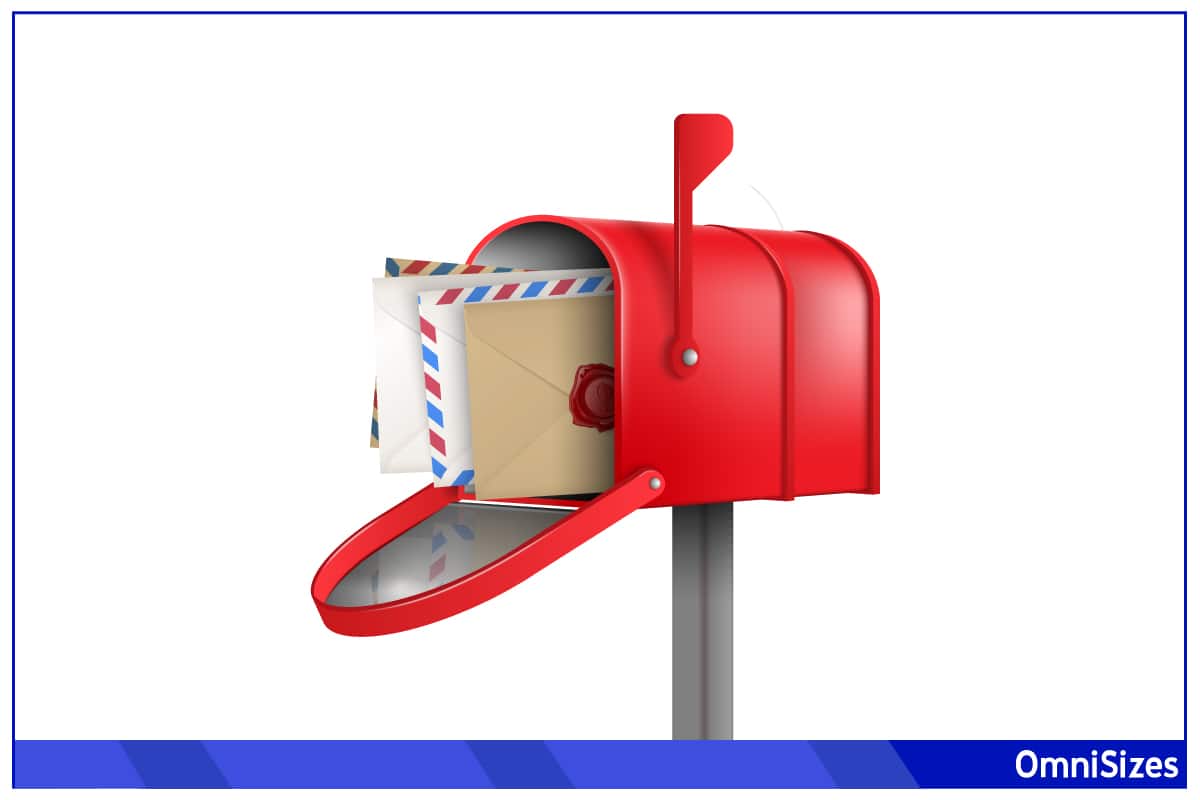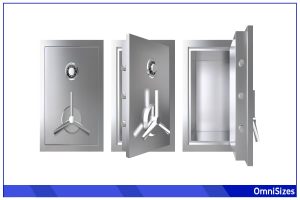Mailboxes are a surprisingly intricate topic, from receiving mail to enhancing our home’s curb appeal. Mailbox sizes are made in such a way that affects our daily lives, even without us knowing. Who knew something so seemingly simple, like mailbox sizes, can be so varied and interesting?
The standard mailbox size for a residential area in the United States is typically around 20 inches long, 7 inches wide, and 9 inches tall (51 × 18 × 23 cm). This size accommodates most daily mail and small parcels, but much larger mailboxes also exist.
This guide will explore the wide range of mailbox sizes, from the standard to the unique, and discuss how these sizes are influenced by regulations and consumer needs.
Types of Mailboxes and Their Sizes
The word “mailbox” may create a certain image in your mental eye, but there’s more than one type. Let’s go over various mailbox types and their sizes.
1. Standard Mailbox Sizes
Standard mailboxes are the most common type you’ll see in neighborhoods. They come in 2 main types: post-mounted, which are often found at the end of a driveway, and wall-mounted, which are attached to a house or building. The typical size for a standard mailbox is around 20 inches in length, 7 inches in width, and 9 inches in height. These dimensions are large enough to accommodate daily mail, including letters, bills, and magazines.
2. Large Residential Mailboxes
For those who receive more mail, or larger packages, large residential mailboxes are a great option. They are similar to standard mailboxes but offer more internal space. You’ll often find these mailboxes with dimensions of approximately 22 inches in length, 11 inches in width, and 15 inches in height. They are ideal for families, home businesses, or individuals who do a lot of online shopping.
3. Locking Mailboxes
With the rise in mail theft, locking mailboxes have become increasingly popular. These mailboxes come with a lock and key mechanism to secure your mail until you retrieve it. Their sizes vary, but a common size for a locking mailbox is about 20 inches in length, 11 inches in width, and 10 inches in height. Some locking mailboxes are designed with larger parcels in mind.
4. Rear Access Mailboxes
Rear access mailboxes offer a convenient solution for safely retrieving mail from behind, ideal for those with roadside mailboxes on busy streets. Typically, they measure around 20 inches long, 10 inches wide, and 11 inches high. This design enhances safety by eliminating the need to step onto the road.
5. Cluster Mailboxes
Cluster mailboxes, often seen in apartment complexes or business parks, are centralized units where mail for multiple recipients is delivered. Each unit within the cluster has its own lock. The overall size of a cluster mailbox can vary greatly depending on the number of units it contains, but individual compartments typically measure around 12 inches in length, 3 inches in width, and 10 inches in height.
6. Commercial Mailboxes
Designed for business use, commercial mailboxes are built to handle a higher volume of mail and larger packages. These mailboxes are often much larger than residential ones, with some models measuring over 30 inches in length, 15 inches in width, and 20 inches in height.
Mailbox Regulations and Standards
Don’t for a second think that mailboxes are just boxes people put up randomly. There are standards that ensure mailboxes are sized and installed correctly.
1. USPS Mailbox Standards
The United States Postal Service (USPS) sets specific regulations for mailboxes. The standards dictate mailbox dimensions, placement, and accessibility. According to USPS, a mailbox should be positioned 41 to 45 inches from the road surface to the bottom of the mailbox or point of mail entry and 6 to 8 inches back from the curb.
2. International Mailbox Standards
Globally, mailbox standards vary. In countries like the UK, Canada, and Australia, postal services set guidelines similar to the USPS, focusing on accessibility, size, and placement. International standards generally require that mailboxes be easily accessible from the main delivery route and protect the mail from weather elements.
3. Materials and Durability Requirements
Mailboxes must be made from durable materials able to withstand weather conditions. Common materials include ferrous metals, heavy-duty plastics, and certain woods. The USPS requires that mailboxes be sturdy enough to protect the mail and maintain their structural integrity over time. They should not pose a hazard to mail carriers or the public.
Choosing the Right Mailbox Size
Picking the perfect mailbox size might seem like a no-brainer, but it’s actually a bit of a balancing act. You want one that’s just right for your daily mail haul, fits in nicely with your home’s vibe, and doesn’t make the mail carrier grumble.
1. Assessing Your Mail Volume
If you frequently receive large packages, a larger mailbox might be necessary. For those who mostly get letters and small parcels, a standard-sized mailbox should suffice. Think about your online shopping habits, subscription services, and the type of mail you regularly receive.
2. Mailbox Placement and Location
If your home is far from the road, a larger mailbox might reduce the need for frequent trips. Urban dwellers with limited space might prefer a compact, wall-mounted mailbox.
3. Security Features for Mail Protection
If security is a concern, consider locking the mailbox. These are available in various sizes and protect your mail from theft. Remember that larger locking mailboxes can accommodate packages, adding an extra layer of security for your online purchases.
4. Home Design Integration
Your mailbox should complement your home’s exterior design. Custom and decorative mailboxes offer more aesthetic flexibility but still need to meet size and functionality requirements. Consider how the mailbox size will fit with your home’s facade and landscaping.
5. Considering Material and Durability
Metal mailboxes are sturdy and can be larger without compromising on strength. Plastic mailboxes are lightweight and resistant to rust but might have size limitations due to durability concerns. Wooden mailboxes offer a classic look but require maintenance and are often available in standard sizes.






